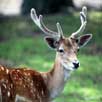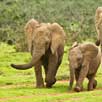National parks
© Copyright 2024-25 by GTI Travels Pvt. Ltd.
The Sariska National Park attracts wildlife enthusiasts and nature lover alike with the vast raw landscape adorning the greenery and having the opportunity for wildlife sighting.

Spreads across the Hills of the Aravali range in the Alwar district of Rajasthan, the Sariska National Park is a famous wildlife destination nearby Delhi, capital of India. The dry deciduous forest of Sariska sprawled over an area of around 860 sq km with the beautiful raw landscape that includes rocky terrain, cliffs, dusty tracks, ruins, grassland, lakes, water bodies, etc. The Sariska forest once was the hunting land preserved for the Royals of Alwar state before the independence of India. In the year 1955, the Sariska forest was declared as the wildlife sanctuary and taken under the Tiger project in the year 1978 making it a tiger reserve forest. In the year 1982, the sanctuary was given the National Park status with the total area of around 273 sq km. The Sariska forest made the history in 2008 to have the first successfully relocated tigers in the reserve park. The forest is known also for having the abundance of mineral resources in the foothills of the Aravali range, but the mining is banned due to maintaining the environmental equilibrium.

The Sariska National Park attracts wildlife enthusiasts and nature lover alike with the vast raw landscape adorning the greenery and having the opportunity for wildlife sighting. The park also a big deal for history lovers as the forest is home to many ruins of the medieval era. The ruins of Garh-Rajor temples of around the 10th century and the Kankwari Fort of the 17th century are the big attractions. The Fort offers you an amazing panoramic view of the forest which is very enchanting. The Pandopil, situated in the Central region of the park, is a popular place as it is said that the Pandavas of Mahabharata epic had visited this place when roaming in exile. The Hanuman temple at Pandopil was visited by the plenty of the followers increasing the rush in the area. The Nilkanth temple has its own grandeur and attracts followers and tourists alike. The Jeep Safari and Canter Safari are organized two times a day for the tourists to explore the forest. The park is divided into the four ecotourism zone among which zone 1 and zone 4 are considered best for wildlife sighting.

The Sariska National Park is known for the rich and diverse wildlife species. Once there was a good number of Royal Bengal Tigers used to roar in the forest before the poaching has left no tiger in the park. However, after the relocation of the tigers from the nearby Ranthambore National Park, the Sariska forest once again becomes the proud habitat of this beautiful endangered wild beast. Apart from the majestic tigers, other wildlife species that enrich the forest are the leopard, Jaguar, Striped Hyena, Jungle Cat and Jackal, which are the prime carnivores along with Caracal and Wild Dogs found occasionally in the forest. The prime herbivores of the forest are Sambhar, Chital, Chinkara, Chausinga, Nilgai, Wild Boar, Porcupine, Langurs, Rhesus Monkey and many others. The park is also a birding destination with plenty of domestic and migratory bird species found in the forest. The bird species like grey partridge, crested serpent eagle, sand grouse, woodpecker, tree pie, horned owl, bush quail, etc. are enriching the avifauna of the park along with around 225 species of birds found here.

The Sariska National Park is the dry deciduous forest with Dhok tree as the prime vegetation of the park, which constitutes around 90 percent of the tree density in the forest. On the slope of the hills, the Salar tree made its place, whereas the Khair and Cheela tree species dominate the valley region. Apart from these dominant trees of the forest, other species of trees and plants are Tendu tree, Bamboo tree, Jamun, Aam, Arjun, Bahera, etc. The Ber, Adusa, Zizyphus and Grewia are the grain species which are found in the plains of the forest. The dried leaves of the Dhok tree are the prime food for the herbivores of the forest in the summer season when there is a scarcity of the grain plants. The forest gets dried after the spring season when the summer arrives and the greenery spreads after the monsoon. After the monsoon, the forest landscape gets the enchanting view with the lush green cover.